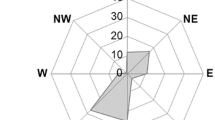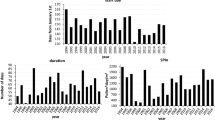Abstract
The pollen of anemogamous plants is responsible for half the allergic diseases, that is to say a prevalence of 10% in the French population. Poaceæ produce the first allergenic pollen almost everywhere. The work described in this article aimed to validate forecast methods for the use of physicians and allergic people who need accurate and early information on the first appearance of pollen in the air. The methods were based on meteorological parameters, mainly temperature. Four volumetric Hirst traps were used from 1995 to 1998, situated in two departments of Burgundy. Two of the methods tested proved to be of particular interest: the sum of the temperatures and the sum of Q 10 values, an agrometeorological coefficient integrating temperature. A multiple regression, using maximum temperature and rainfall, was also performed but it gave slightly less accurate results. A χ 2-test was then used to compare the accuracy of the three methods. It was found that the date of onset of the pollen season could be predicted early enough to be useful in medical practice. Results were verified in 1999, and the research must be continued to obtain better statistical validity.
Similar content being viewed by others
Author information
Authors and Affiliations
Additional information
Received: 1 March 2000 / Accepted: 14 July 2000
Rights and permissions
About this article
Cite this article
Laaidi, M. Forecasting the start of the pollen season of Poaceæ: evaluation of some methods based on meteorological factors. Int J Biometeorol 45, 1–7 (2001). https://doi.org/10.1007/s004840000079
Issue Date:
DOI: https://doi.org/10.1007/s004840000079




